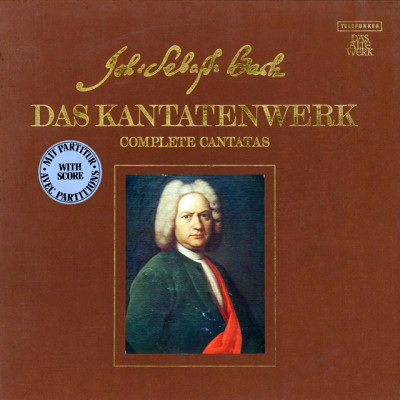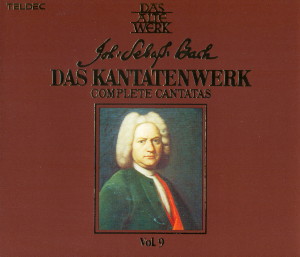 |
|
2 LPs
- SKW 9/1-2 - (p) 1974
|
 |
| 2 CDs -
8.35035 ZL - (c) 1986 |
|
| DAS KANTATENWERK - Volume 9 |
|
|
|
|
|
|
|
| Johann Sebastian
BACH (1685-1750) |
Kantate
"Liebster Jesu, mein Verlangen", BWV
32
|
|
23' 39" |
|
|
Kantate
am 1. Sonntag nach Epiphanias (Dominica
1 post Epiphanias)
|
|
|
|
|
Text:
Lehms 1711; 2. nach Lukas 2,49; 6. Paul
Gerhardt 1647 (Weg, mein Herz, mit den
Gedanken)
|
|
|
|
|
- 1.
Aria (Soprano): "Liebster Jesu, mein
Verlangen" |
5' 42" |
|
B1 |
|
- 2.
Recitativo (Basso): "Was ist's, daß du
mich gesuchet?" |
0' 27" |
|
B2 |
|
- 3.
Aria (Basso): "Hier, in meines Vaters
Stätte" |
7' 35" |
|
B3 |
|
- 4.
Recitativo (Soprano, Basso): "Ach!
heiliger und großer Gott" |
2' 50" |
|
B4 |
|
- 5.
Aria (Soprano, Basso): "Nun verschwinden
alle Plagen" |
6' 00" |
|
B5 |
|
- 6.
Choral (Coro): "Mein Gott, öffne mir die
Pforten" |
1' 05" |
|
B6 |
|
|
|
|
|
|
Kantate
"Allein zu dir, Herr Jesu Christ",
BWV 33 |
|
21' 11" |
|
|
Kantate
am 13. Sonntag nach Trinitatis (Dominica
13 post Trinitatis) |
|
|
|
|
Text:
1. und 6. Konrad Hubert 1540; 2.-5.
Umdichtung eines unbekannten Verfassers |
|
|
|
|
- 1.
Choralchorsatz (Coro): "Allein zu dir,
Herr Jesu Christ" |
4' 51" |
|
C1 |
|
- 2.
Recitativo (Basso): "Mein Gott und
Richter" |
1' 05" |
|
C2 |
|
- 3.
Aria (Alto): "Wie furchtsam wankten meine
Schritte" |
8' 04" |
|
C3 |
|
- 4.
Recitativo (Tenore): "Mein Gott, verwirf
mich nicht" |
1' 11" |
|
C4 |
|
- 6.
Aria (Tenore, Basso): "Gott, der du die
Liebe heißt" |
4' 35" |
|
C5 |
|
- 7.
Choral (Coro): "Ehr sei Gott in dem
Höchsten Thron" |
1' 25" |
|
C6 |
|
|
|
|
|
Walter
Gampert (Solist des Tölzer
Knabenchor), Sopran
René Jacobs, Alt
Marius van Altena, Tenor
Max van Egmond, Baß
Knabenchor Hannover |
Hans Henning, Leitung
Das verstärkte LEONHARDT-CONSORT mit
Originalinstrumenten
- Sigiswald Kuijken (BWV 32,3), Marie
Leonhardt, Lucy van Dael, Alda Stuurop,
Antoinette van den Hombergh, Janneke van der
Meer, Violinen
- Martin Sonneveld (BWV 32,6; 33,1; 33,6),
Wim ten Have, Wiel Peeters, Violen
- Anner Bylsma, Dijck Koster, Richte van der
Meer (BWV 32,4), Violoncelli
- Anthony Woodrow, Violone
- Ku Ebbinge (BWV 32,1; 32,5), Bruce Haybes
(BWV 32,6), Oboen
- Gustav Leonhardt, Ton Koopman (BWV 32,1;
32,4), Orgel
Gustav Leonhardt, Gesamtleitung
|
|
|
|
|
|
Luogo
e data di registrazione |
|
Amsterdam (Holland) -
Aprile 1972 / Febbraio 1974
|
|
|
Registrazione: live
/ studio |
|
studio |
|
|
Producer |
|
Wolf Erichson
|
|
|
Prima Edizione LP |
|
Telefunken "Das Alte
Werk" | SKW 9/1-2 | 2 LPs - durata
44' 53" - 39' 50" | (p) 1974 | ANA
|
|
|
Edizione CD |
|
Teldec Classics |
LC 6706 | 8.35035 ZL | 2 CDs -
durata 44' 53" - 39' 50" | (c)
1986 | ADD |
|
|
Cover
|
|
Johann Sebastian
Nach, einige Jahre vor seiner
Ernennung zum Kantor in Leipzig.
Gemälde con JJ. Ihle (1720) Bach
Museum Eisenach.
|
|
|
Note |
|
In questo volume sono
presenti anche La Cantate BWV 31 e
BWV 34 a cura del Concentus
Musicus Wien diretto da Nikolaus
Harnoncourt.
|
|
|
|
|
INTRODUCTION
by Alfred Dürr
“Liebster Jesu, mein
Verlangen” (BWV 32),
based on a text by Georg
Christian Lehms, belongs to
the third Leipzig cantata
cycle by Bach and was
composed on 13th January,
1726. The text is linked up
with reading of the gospels
by the 12-year-old Jesus in
the temple and features the
form, popular since the 17th
century, of a dialogue
between Jesus and the soul.
It draws its inner tension
from the conditions of
god-forsakenness and
consolation in God, which
are understood as the basic
situations of human
existence.
The introductory aria,
arranged on the pattern of a
slow concerto movement, is
of exceptional beauty:
Superimposed on short string
chords, the oboe and soprano
produce in concertante form
widely-spanning,
richly-ornamented arcs of
melody. Whereas the centre
(bass) aria with its almost
virtuoso violin part is
still pervaded with deep
gravity (note the harmonic
gloominess on “betrübter
Geist” = troubled souls),
the final duet strikes up
notes of unclouded, almost
exuberant joy. The final
chorale, the 12th verse of
the hymn “Weg, mein Herz,
mit den Gedanken” = Away, my
heart, with such thoughts,
by Paul Gerhardt (melody:
Freu dich sehr, o meine
Seele = Rejoice greatly, O
my soul), was not provided
for in the text, but was
added by Bach.
“Allein zu dir, Herr Jesu
Christ” (BWV 33) is a
chorale cantata of the
second Leipzig cycle,
composed for 3rd September,
1724. It is based on the
three-verse song by Konrad
Hubert of 1540, with the
additional verse from the
same year. The first and
last verses from this were
taken over unchanged
textually and with their own
chorale melody, while the
two inner verses were
transposed by an unknown
text arranger into a
recitative-aria pair each.
The reason for the choice of
this hymn - the gospel
reading for the Sunday tells
the parable of the good
Samaritan - is probably in
the main the phrase from
verse 3 “vor allen Dingen
lieben dich und meinen
Nächsten als mich” = above
all lovethee and my
neighbours as myself, which
has appeared in cantata
section 5; on the whole,
however, thethematic
connection is only rather
loose. From the abundance of
musical ideas just a few are
mentioned here. The
introductory chorus accords
with the type used by Bach
in most cases; the chorale
is inserted line by line
into a concertante
orchestral movement with its
own thematic style; the song
melody lies in the soprano
part, supported by the other
singing voices in part
chordal and part imitative
setting. Of particular charm
is the text-engendered theme
of the alto aria (section
3), the clarity of which is
perfectly revealed.
Contrasting with this is the
second aria (section 5), a
duet for tenor and bass with
two obbligato oboes, with
its warm tone entirely
attuned to vocal rendition:
instrumental and vocal
melodies fuse with one
another.
|
  |
|
|